
|
of History & Folklore
The most in-depth, comprehensive site about the Skagit
Covers from British Columbia to Puget Sound. Counties covered: Skagit, Whatcom, Island, San Juan, Snohomish & BC. An evolving history dedicated to committing random acts of historical kindness
|
Noel V. Bourasaw, founder  Sedro-Woolley, Washington, 98284
Sedro-Woolley, Washington, 98284
Home of the Tarheel Stomp  Mortimer Cook slept here & named the town Bug Mortimer Cook slept here & named the town Bug
|

|
Site founded Sept. 1, 2000. We passed 7.75 million page views on January 2017
The home pages remain free of any charge.
Please pass on this website link to your family, relatives, friends and clients.
|
Profiles of the Davis family of Cedar Bar,
Skagit River, Part One
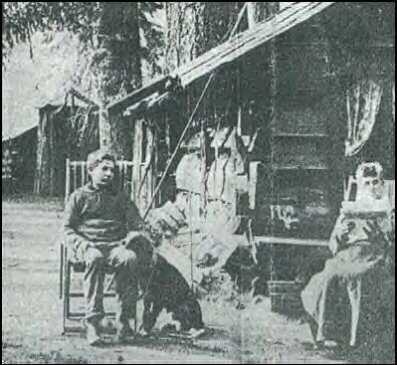 | Glee Davis and his mother, Lucinda, at Cedar Bar, circa 1900
|
The excerpts below from the book, Skagit Settlers, illustrate how fine that book is. Although it was published nearly 30 years ago, you can purchase a reprint at the Historical Museum in
La Conner. Several people have used our search box to look for stories about Lucinda Davis and her family. She was one of several single women who made a very big mark on the upper Skagit river area. Her sons Frank and Glee grew up to become central characters in opening up that area to exploration and mining, and Glee turned out to be quite a writer and public speaker. We are preparing an in-depth story on the family and their activities, but we present these profiles as an introduction. See the extensive links in the Davis Portal section to many stories by and about them and their pioneer experience as an early hospitality center in the North Cascades.
|
Lucinda Davis family
From theConcrete Herald, 1966
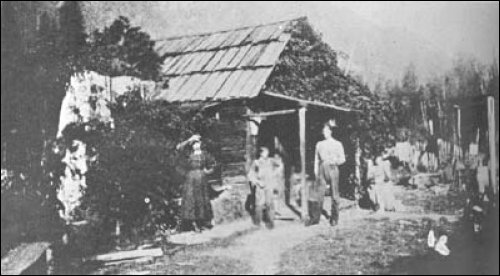
|
This is the Davis cabin at their property near the Cascade River, before the 1897 flood that washed their buildings away, and their following move to Cedar Bar.
|
Lucinda Davis was the daughter of a Methodist minister in Pennsylvania. She had divorced her husband and in 1890 moved from her home in Colorado with her three children. She settled on the Cascade river on the homestead of her brother, George Leach, who had drowned a few months before. The family stayed on the claim during the summer and moved to Mount Vernon in the fall so that the children could attend school
On Nov. 17, 1897, the Cascade river flooded and destroyed the Davis homestead. Lucinda and her children then moved to Cedar Bar on the Skagit and built a log house near an old cabin which had once been the house of an Indian named Charlie Moses. Cedar Bar was a convenient midway point on the Skagit Trail and Lucinda Davis began operation of a roadhouse for miners traveling to the Ruby or Thunder Creek mines
Each year after 1898 the roadhouse was opened about April and closed in November. The family raised hay up river at Beaver creek and carried it down to sell to travelers. Glee Davis, Lucinda's youngest son, built a water wheel on Stetattle creek and attached it to a grist mill for grinding flour. A flood carried away the water wheel a few years later in 1900 the roadhouse burned but was rebuilt the next spring.
In January 1907, Glee and Lucida Davis traveled from Mount Vernon to Cedar Bar. The weather was bad and the trip upriver was dangerous. Lucinda described the trip in a letter written to daughter Idessa who attended school in Tacoma:
Glee met us at the Marblemount store at noon, Jan. 28th. The stage had been run mounted on a sled as it has been cold for so long. We get our belongings together and started upriver and arrived at the Talc Mines before dark. . . .
Leaving there we walked the six miles to Babcock's cabin where I cooked supper while Glee shoveled the snow off the roof. Mr. Babcock is working at the Talc, and his barn has already been broken down by the snow. We went the next three miles to Goodell's after dark and it began snowing before we got there. . . .
In the morning we started out in the deep snow that had fallen during the night and could hardly see the old tracks. Took us one hour to go the one mile to the canyon, but thought that might be the worst part, then three hours to the Mason bridge about two miles more. The slides were numerous and in some places we could hardly find the trail. . . .
The Devil's Corner was icy but not dangerous when we were careful. Twice I got an avalanche of snow from a big fire tree on me, it nearly suffocated me but I just stood still and let it come. . . .
They were unable to reach Cedar Bar in one day and camped for the night near Midway Creek:
. . . at four o'clock we built a fire under the big bluff at the foot of long hill, two and a half miles from home. Toward morning the snow came off the bluff about 300 feet high and came near putting our fire out several times, but we slept some. We could hear snow slides all night. It began to rain about five a.m. and we started at seven. . . .
We were thirty minutes going up the long hill. We hurried all we could for fear of the slides and were glad to find that Two-mile creek had not slid at all. We got to the mid-way point where the trail was blasted into the rock, afraid every second that the ice would break and fall, then here the trail seems to have broken off, but we are not sure. We clung to the bluff until we reached the last section of the bridge and I could not see how we could get over for the snow and ice was much higher than the bridge railings and up to a sharp point, but by bracing himself against the bluff, Glee got over the worst. Had he slipped, he would have gone between the bluff and the bridge and it was all ice to the river about sixty feet.
Finally the two came within sight of their cabin:
When we got to the fishing hole we saw a lot of smoke up at our place and were afraid that the house was on fire, the snow looked all brown through it. Jack Ring, a neighbor, was burning wet bark. . . .
I was one hour and twenty minutes from the fishing hole to the cabin. I got my feet in hot water and drank a cup of tea and ate some beans and went to bed.
Home on the Cascade River
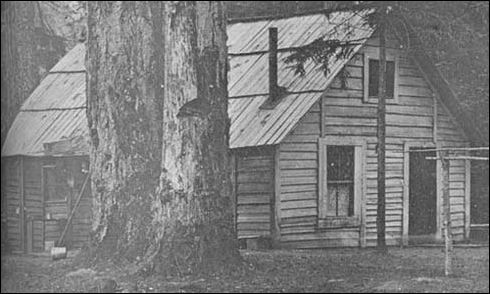
|
This is the Davis ranch near Diablo and the house that was rebuilt after careless travelers burned the original cabin to the ground in 1900.
|
By Frank E. Davis, excerpts fromSkagit Settlers, edited by Charles Dwelley
(La Conner: Skagit County Historical Society, 1979, reprint for sale at museum)
Our family, my mother, Lucinda J. Davis, sister Idessa, and brother Glee and myself, accompanied by my uncle Will E. Leach, arrived at Marblemount Aug. 1, 1890, and reached our homestead on Cascade river about one mile from its junction with Skagit river the next morning. This homestead was originally located by my uncle George S. Leach, who was drowned there in May 1890 while crossing the river in high water with Dick Touey
There was much activity on Cascade river at that time as the Great Northern Railway was surveying and it was generally thought that this would be the route through the mountains. Many prospectors were traveling the trail and a large pack train operated by Alex Adkins and Bob Vorhies was making regular trips to Gilbert's Cabin
At that time the Marblemount ferry was a quarter mile above the present river bridge and operated by Morgan W. Davies, Mrs. M. Clark [Matilda Buller], with her sons Carl, Wade and Richard Lee Buller, ran a hotel there; Borgardus & Stewart, a general store; and John Rusner and George Ingalls, a saloon. The Indian family of Moses: Black Moses, Charley, George and Harry, and numerous relatives had the place later bought from them by Billy Barratt [William Barratt, an English immigrant].
On Cascade river, first was Simon Moses' place and above that was the Indian camp consisting of Abe Moses family and the Jesus family. About a mile farther up they had a fish trap for catching salmon. Near this Joe Emord brought his wife and small son Madore to take up a homestead in 1890. The last of December, 1891, Mr. Emord got into a fight with Frank Barns [Barnes?] and was killed; his funeral was held on his homestead Jan. 3, 1893. There were many homesteaders along the Cascade, vis: Durand Taylor, Scotty Lowden, Harry Colby, Joe Moha (the Polander) near Marble creek; then Frank Bart, Doty, Sibley, Tom Perley, Hurd, Al Kindy, Truax, Tom Barratt and John McCaffery. At the forks of the river, later named Mineral Park, John Kinsella and Oleson ran a general store and Doty ran a saloon. About a mile or two above this at the marsh, Will Leach located a homestead and it was there in 1897 that Gifford Pinchot visited and spent a day with him on his trip through the western forests. This was the last habitation until Gilbert's Cabin
Gilbert Landre, a French Canadian, came into this district about 1888 and built the first cabin, a small one of logs, and partly dug into the hillside, with a small fireplace for cooking and heating. I first saw him there in 1893 while I was packing for a small survey party, conducted by J.C. Parsons, who was making a map of the mining district. Gilbert was then hewing the logs for the new house. He had the walls about half-way up in the spring of '93 when a snow slide came across from the opposite side and wrecked it. The present cabin was completed the following year, and I have stayed there many times during the next ten years. Gilbert was a great prospector, but I know of no mines that he located. He used to say, "Not much "minera-al," but good indications (he pronounced it: inda-ca-shons). [See the table of contents for Issue 35 for the Gilbert Landre cabin story]
Jack and George Rowse were among the first prospectors in the district and located the Boston mine [this Journal website]. The district also had its lost mine like other places. A company of solders came over the pass in the early days and one of them found some rock that reportedly showed much gold. It was later searched for and the Soldier Boy claim was located on what was thought to be the place the gold-bearing rock came from. The only ore I took for there showed only iron pyrite. Many mines were located around that district — the El Dorado, Johannasburg, Horseshoe, Doubtful, Warrier, Blue Devil, Mammouth, Cascade, Silver Butte, Ironclad, and many others. [All are spelled verbatim.]
In the summer of 1891, a Bohemian artist (Mrs. Billington) persuaded my mother and sister to accompany her on a trip to Horseshoe Basin where she had been hired to paint the mountains. They had quite a tedious trip, but one not to be forgotten. They crossed Doubtful lake on a raft.
During 1896 and '97 the Cascade wagon road was built about twelve miles up the river to Hurd's cabin. It followed quite near the river and at Lookout mountain bluff it was constructed on bridges. The road was short-lived though, and in the flood of Nov. 17, 1897, much of it was destroyed. See
this Journal website
about the early wagon road.
Our homestead was washed away during this flood, taking all of the buildings except the barn. All of the cleared land was later washed away, the present Cascade river bridge crosses over what was then the lower end of eight acres of garden and hay land.
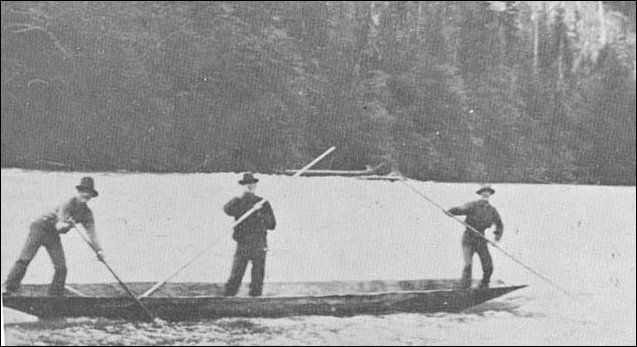
|
During the time that the Davises lived upriver, the primitive wagon roads were barely passable a few months out of the year, so canoes were the preferred mode of travel on rivers and streams. This photo from the book, Chechacos All (reprint for sale at the
La Conner Museum), is captioned: "Canoe as prospectors' transportation — Frank Davis, Colonel Chapman and Carl Buller.
|
Endnotes
Mrs. Billington
We have never found a record of this artist. Do you know of her? We would love to find one of her paintings that resulted from this trip. [Return]
Links, background reading and sources
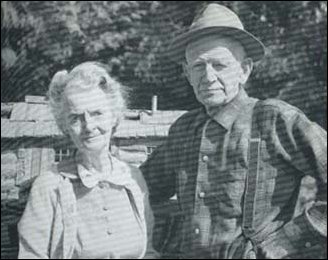 |
Glee and Hazel Davis
|
Story posted on Jan. 29, 2002, last updated and moved to this domain Aug. 5, 2006
Please report any broken links so we can update them
updated October 2018
|
Did you find what you were seeking? We have
helped many
people find individual names or places,
email if you have any
difficulty.
|
Tip: Put quotation marks around a specific name or item of two
words or more, and then experiment with different combinations of the words without
quote marks. We are currently researching some of the names most recently searched for
— check the list
here. Maybe you have searched for one of them?
|
|
 See this Journal
Timeline website of local, state, national, international events for years of the
pioneer period. See this Journal
Timeline website of local, state, national, international events for years of the
pioneer period.
 Did you enjoy these stories and histories?
The process continues as we compile and collaborate on research about Northwest
history. Can you help?
Remember; we welcome correction, criticism and additions to the record. Did you enjoy these stories and histories?
The process continues as we compile and collaborate on research about Northwest
history. Can you help?
Remember; we welcome correction, criticism and additions to the record.
 Please report any broken links or files that do
not open and we will send you the correct link. With more than
800 features, we depend on your report. Thank you. Please report any broken links or files that do
not open and we will send you the correct link. With more than
800 features, we depend on your report. Thank you. |
|
Donations always welcomed!
Donations make a difference. We are a 501 (c) (3)
nonprofit corporation. Your monetary gifts are tax deductible, actively
solicited, and most welcome. Unless instructed otherwise, your contribution
will be kept confidential. If you would like to make a donation to
contribute to any of the works of Skagit County Historical
Society and Museum. From your PayPal account,
consider specifying if you would like your donation restricted to a specific
area of interest: General Funds, Skagit River Journal, Skagit City School,
Facilities, Publication Committee, Special Events, any upcoming Exhibit. Just add those
instructions in the box provided by PayPal. If not a donation, how about a
Membership?
Find information at this link. Thank-you! from the Director, staff and Board of
Trustees.
|
|
Please sign our guestbook so our readers will know where you found out about us, or
share something you know about the Skagit River or your memories or those of your
family. Share your reactions or suggestions or comment on our Journal. Thank you for
taking time out of your busy day to visit our site.
Currently
looking for a new guestbook!
|

View My Guestbook
Sign My Guestbook
|
Email us at: skagitriverjournal@gmail.com

Mail copies/documents to Street address: Skagit River Journal c/o Skagit County
Historical Society, PO Box 818, 501 S.4th St., La Conner, WA. 98257
|
|







